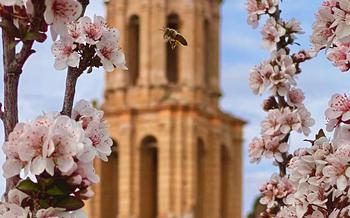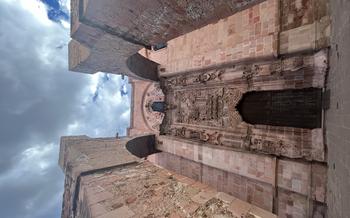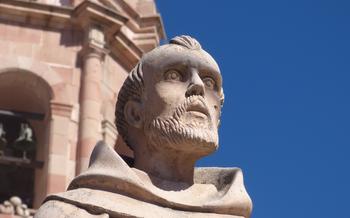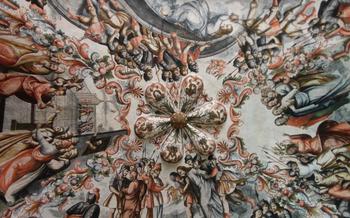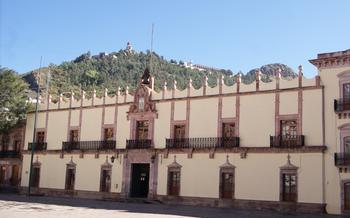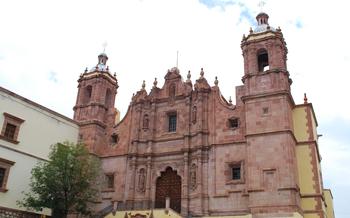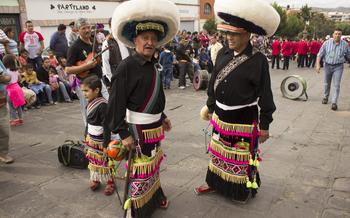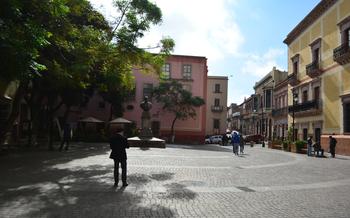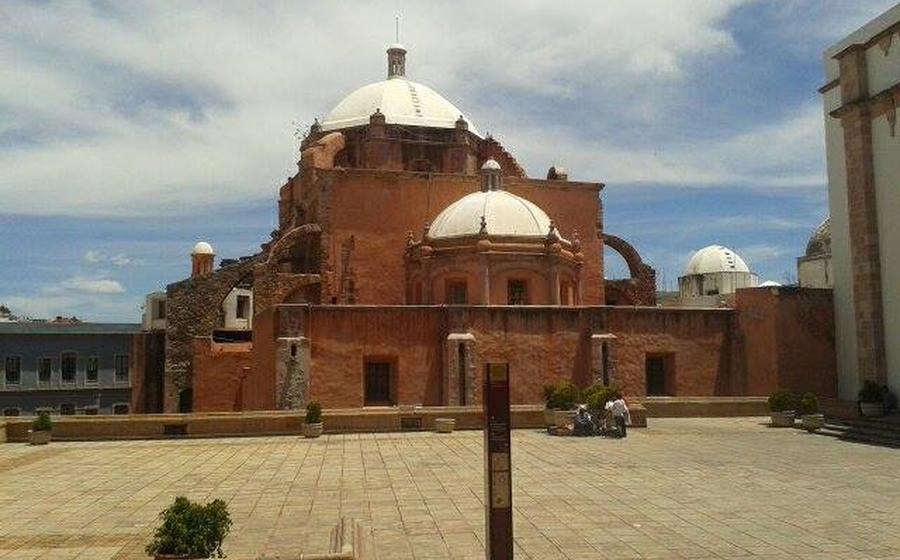
Templo de San Agustín
- Architectural Marvel
- Visiting the Temple
- Location and Accessibility
- Historical Context
- Legends and Folklore
- Restoration and Preservation
- Local Traditions
- Religious Significance
- Artistic Masterpieces
- Photography and Instagrammability
- Local Cuisine and Restaurants
- Insider Tip:
Architectural Marvel
The Templo de San Agustín is a stunning example of Baroque architecture, showcasing the intricate carvings, sculptures, and reliefs that are characteristic of this style. The facade is adorned with elaborate Churrigueresque ornamentation, featuring twisting columns, floral motifs, and the figures of saints and angels. The interior of the church is equally impressive, with its barrel-vaulted ceiling, ornate altars, and gilded decorations. The main altarpiece, a masterpiece of Churrigueresque style, is a riot of color and detail, featuring carved figures, paintings, and a resplendent gold leaf finish. The use of pink cantera stone, a distinctive feature of Zacatecas's architecture, adds a warm and inviting glow to the church's interior. The symbolism and iconography depicted in the church's design reflect the religious and cultural beliefs of the Augustinian Order and the local community.
Visiting the Temple
Visiting the Templo de San Agustín is a must for anyone interested in exploring Zacatecas's rich history and cultural heritage. The church is open to the public daily, with guided tours available for a more in-depth experience. It is recommended to visit during the morning hours to avoid the crowds and capture the best light for photography. Visitors should plan to spend at least an hour exploring the temple's stunning architecture, intricate artwork, and opulent interior.
Coinciding a visit with the annual feast of San Agustín, held in late August, is a unique opportunity to witness the vibrant celebrations and festivities that fill the city's streets. Visitors can join the colorful processions, enjoy live music and performances, and immerse themselves in the infectious energy of the local community.
Nearby attractions that complement a visit to the Templo de San Agustín include the Museo Pedro Coronel, showcasing a diverse collection of modern and contemporary art, and the Mina El Edén, a former silver mine that offers guided tours and insights into Zacatecas's mining history.
After exploring the temple, visitors can savor the flavors of Zacatecas's cuisine at nearby restaurants. La Canasta, known for its traditional Mexican dishes, is a popular choice. For a unique dining experience, visitors can opt for La Casona de los Vitrales, housed in a 19th-century mansion and offering a menu inspired by regional ingredients and flavors.
Location and Accessibility
The Templo de San Agustín is strategically situated in the heart of Zacatecas's historic center, a UNESCO World Heritage Site. Visitors can effortlessly explore this architectural gem on foot, immersing themselves in the city's colonial charm. Alternatively, for those arriving by car, ample parking options are available in the vicinity of the church. Public transportation also provides convenient access, with several bus routes stopping within walking distance. Notably, the church is wheelchair accessible, ensuring an inclusive experience for all visitors.
Historical Context
The construction of the Templo de San Agustín is deeply rooted in the historical context of Spanish colonization and the rise of Catholicism in Mexico. During the 16th century, Spanish conquistadors arrived in Zacatecas, drawn by the discovery of rich silver deposits. The rapid growth of mining led to the establishment of numerous settlements and the construction of churches to serve the spiritual needs of the growing population.
The Templo de San Agustín was built in the 18th century, during a period of great prosperity and cultural flourishing in Zacatecas. The Augustinian Order, a Catholic religious order, played a pivotal role in the construction and administration of the church. They were responsible for bringing the Catholic faith to the region and establishing religious institutions to support the local community.
The Mexican Revolution, which took place in the early 20th century, had a significant impact on the Templo de San Agustín. The church was damaged during the fighting and fell into disrepair. However, after the revolution, the temple underwent extensive restoration efforts and was eventually restored to its former glory.
Today, the Templo de San Agustín stands as a testament to Zacatecas's rich history and heritage. It is a symbol of the city's deep-rooted Catholic faith and its resilience in the face of adversity. The church continues to play an important role in the religious and cultural life of Zacatecas, serving as a place of worship, contemplation, and community gathering.
Legends and Folklore
The Templo de San Agustín is steeped in local legends and folklore, adding to its mystique and charm. One popular tale speaks of a hidden treasure buried beneath the church, said to have been left by the Augustinian friars during the Mexican Revolution. Treasure hunters have searched for years, but the riches remain undiscovered.
Another legend tells of a ghostly apparition that haunts the church, believed to be the spirit of a former priest who was tragically killed during the construction of the temple. Visitors have reported seeing the ghost wandering the aisles, searching for peace and redemption.
These stories have been passed down through generations, shaping the cultural identity of Zacatecas. They add a sense of mystery and intrigue to the Templo de San Agustín, making it not just a historical and architectural marvel but also a place of whispered secrets and untold tales.
Restoration and Preservation
The Templo de San Agustín has undergone extensive restoration efforts in recent years to preserve its architectural integrity and historical significance. The restoration process involved meticulous cleaning and repairs to the exterior and interior of the church, using traditional techniques and materials.
One of the main challenges faced during the restoration was the need to raise funds to support the project. The local community, government agencies, and private donors came together to contribute to the restoration efforts, demonstrating their commitment to preserving this cultural treasure.
Specialized expertise was required to restore the intricate carvings, sculptures, and artwork that adorn the church. Skilled craftsmen and artisans worked diligently to repair and conserve these delicate elements, ensuring that the original beauty and craftsmanship of the temple were maintained.
The restoration of the Templo de San Agustín is an ongoing process, with the goal of preserving this magnificent church for future generations. Conservation projects and initiatives are continuously being implemented to ensure that the temple remains a symbol of Zacatecas's rich history and cultural heritage.
Local Traditions
The Templo de San Agustín is deeply intertwined with the local traditions and customs of Zacatecas. One of the most significant traditions is the blessing of candles, which takes place on the feast day of San Agustín, the patron saint of the church. Devotees bring their candles to the church to be blessed by the priest, believing that these candles will bring good luck, protection, and healing. Another important tradition is the veneration of particular saints, each associated with specific favors or miracles. For example, San Judas Tadeo is known for helping with difficult causes, while San Martín Caballero is invoked for protection against illness. These traditions play a vital role in the everyday lives of the local community, providing spiritual guidance and comfort. Unique rituals and ceremonies, such as the annual procession in honor of San Agustín, further contribute to the cultural richness of Zacatecas.
Religious Significance
The Templo de San Agustín holds immense religious significance for the Catholic community in Zacatecas. It serves as a spiritual haven, providing guidance, solace, and support to the local faithful. The church is a place of worship, contemplation, and prayer, where devotees come to connect with their faith and seek divine intervention. Throughout the year, the temple hosts various religious ceremonies, including masses, baptisms, weddings, and special devotions. It is also a popular destination for pilgrimages, with believers from across the region flocking to the church to pay homage to its patron saint, San Agustín, and to seek his intercession. The Templo de San Agustín stands as a testament to the deep religious traditions and beliefs that are deeply ingrained in the cultural fabric of Zacatecas.
Artistic Masterpieces
The Templo de San Agustín is home to a remarkable collection of artworks that reflect the artistic and cultural heritage of Zacatecas. Visitors can admire stunning paintings, intricate sculptures, and awe-inspiring murals that adorn the walls and altars of the church.
The main altarpiece is a masterpiece of Churrigueresque style, with its elaborate carvings, gilded embellishments, and vibrant colors. The altarpiece depicts scenes from the life of Saint Augustine, the patron saint of the church.
Other notable artworks include the sculpture of the Virgen de Guadalupe, the patron saint of Mexico, which is located in the main chapel. The church also houses a collection of paintings by Miguel Cabrera, one of the most renowned artists of the colonial period.
These artworks are not just decorative elements; they also serve to enhance the spiritual and emotional experience of visitors. The intricate details and symbolism in the paintings and sculptures invite contemplation and reflection.
Visitors should take their time to explore the church and discover the many hidden artistic treasures that it holds. Each artwork tells a story and contributes to the rich tapestry of the Templo de San Agustín.
Photography and Instagrammability
The Templo de San Agustín is a photographer's paradise, with its striking Baroque architecture and ornate interior providing endless opportunities for capturing stunning shots. To make the most of your photography experience, come prepared with a wide-angle lens to capture the church's imposing facade and a tripod for steady shots of the intricate details. For interior photography, use a low ISO setting to minimize noise and a flash to illuminate the dimly lit areas. Don't miss the opportunity to capture the church's beautiful stained glass windows, which cast a warm glow on the interior. If you're an Instagram enthusiast, the Templo de San Agustín offers plenty of Instagrammable spots. Capture the grandeur of the church's facade against the backdrop of the clear blue sky, or focus on the intricate carvings and reliefs that adorn the exterior. Inside, the opulent altars and religious artwork provide a feast for the eyes, while the soft, natural light filtering through the stained glass windows creates a magical atmosphere. Share your photos using #TemploDeSanAgustin and #Zacatecas to connect with other travelers and inspire them to visit this architectural masterpiece.
Local Cuisine and Restaurants
After exploring the grandeur of the Templo de San Agustín, satisfy your taste buds with the delectable flavors of Zacatecan cuisine. The city is renowned for its rich culinary traditions, influenced by its mining history and diverse cultural heritage.
For an authentic Zacatecan experience, head to one of the many local restaurants and cafes nestled near the temple. Try traditional dishes such as "enchiladas zacatecanas," known for their unique green sauce made with fresh herbs and chili peppers. Alternatively, savor the hearty "pozole," a rich stew made with hominy, meat, and a flavorful broth.
Don't miss out on "asado de boda," a slow-cooked barbacoa-style lamb dish often served at special occasions. And for a sweet treat, indulge in "borrachitos," a type of cake soaked in syrup and topped with fruit and nuts.
For a memorable dining experience, visit the Mercado González Ortega, a bustling market located just a short walk from the temple. Here, you can sample a variety of local delicacies, from fresh produce to traditional dishes prepared by local vendors.
As you savor the flavors of Zacatecas, remember that food is an integral part of the city's cultural identity. Each bite tells a story of the region's history, traditions, and the warm hospitality of its people.
Insider Tip:
For a truly immersive experience, visit the Templo de San Agustín during the annual feast of San Agustín, held on August 28th. The church is adorned with colorful decorations, and the streets come alive with music, dancing, and processions. Participate in the festivities, sample the local cuisine, and witness the deep devotion of the Zacatecan people to their patron saint. It's a vibrant celebration that showcases the cultural heritage of Zacatecas and offers a glimpse into the heart of this historic city.
